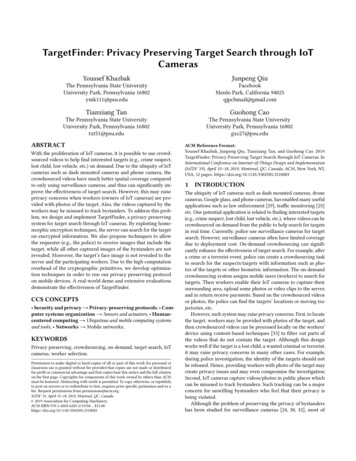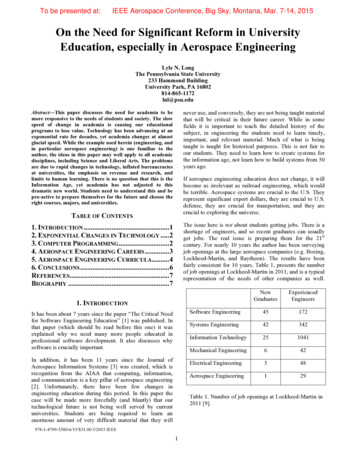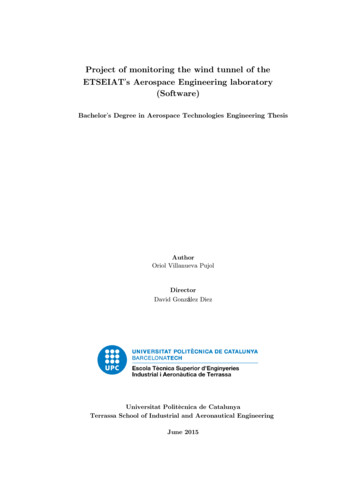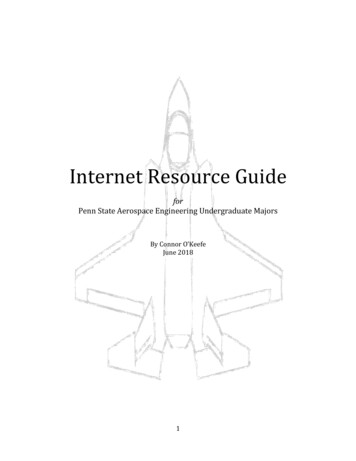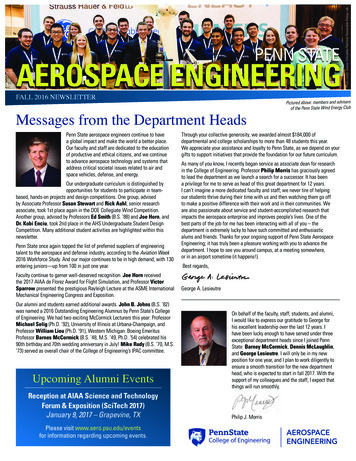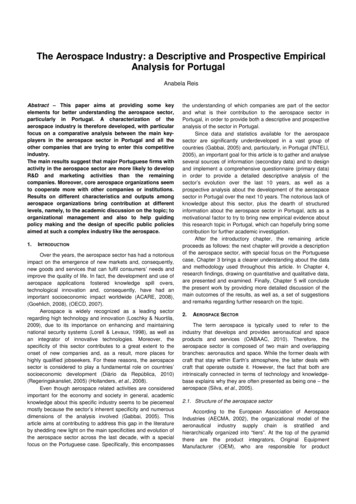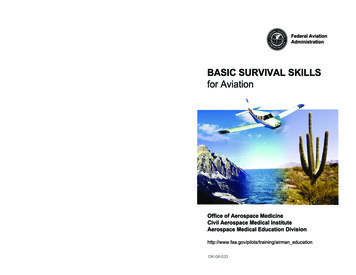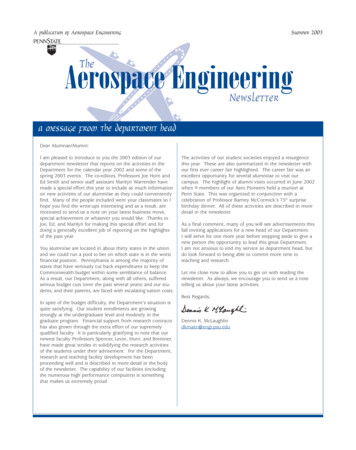
Transcription
A publication of Aerospace EngineeringSummer 2003TheAerospace EngineeringNewslettera message from the department headDear Alumnae/Alumni:I am pleased to introduce to you the 2003 edition of ourdepartment newsletter that reports on the activities in theDepartment for the calendar year 2002 and some of thespring 2003 events. The co-editors, Professors Joe Horn andEd Smith and senior staff assistant Marilyn Warrender havemade a special effort this year to include as much informationon new activities of our alumni/ae as they could convenientlyfind. Many of the people included were your classmates so Ihope you find the write-ups interesting and as a result, aremotivated to send us a note on your latest business move,special achievement or whatever you would like. Thanks toJoe, Ed, and Marilyn for making this special effort and fordoing a generally excellent job of reporting on the highlightsof the past year.You alumni/ae are located in about thirty states in the unionand we could run a pool to bet on which state is in the worstfinancial position. Pennsylvania is among the majority ofstates that have seriously cut back expenditures to keep theCommonwealth budget within some semblance of balance.As a result, our Department, along with all others, sufferedserious budget cuts (over the past several years) and our students, and their parents, are faced with escalating tuition costs.The activities of our student societies enjoyed a resurgencethis year. These are also summarized in the newsletter withour first ever career fair highlighted. The career fair was anexcellent opportunity for several alumni/ae to visit ourcampus. The highlight of alumni visits occurred in June 2002when 9 members of our Aero Pioneers held a reunion atPenn State. This was organized in conjunction with acelebration of Professor Barney McCormick’s 75th surprisebirthday dinner. All of these activities are described in moredetail in the newsletter.As a final comment, many of you will see advertisements thisfall inviting applications for a new head of our Department.I will serve for one more year before stepping aside to give anew person the opportunity to lead this great Department.I am not anxious to end my service as department head, butdo look forward to being able to commit more time toteaching and research.Let me close now to allow you to get on with reading thenewsletter. As always, we encourage you to send us a notetelling us about your latest activities.Best Regards,In spite of the budget difficulty, the Department’s situation isquite satisfying. Our student enrollments are growingstrongly at the undergraduate level and modestly in thegraduate program. Financial support from research contractshas also grown through the extra effort of our supremelyqualified faculty. It is particularly gratifying to note that ournewest faculty Professors Spencer, Levin, Horn, and Brentner,have made great strides in solidifying the research activitiesof the students under their advisement. For the Department,research and teaching facility development has beenproceeding well and is described in more detail in the bodyof the newsletter. The capability of our facilities (includingthe numerous high performance computers) is somethingthat makes us extremely proud.Dennis K. McLaughlindkmaer@engr.psu.edu
Awards & RecognitionFacultyGeorge A. Lesieutre, professor, was awarded the AIAA ZaremEducator Award recognizing his careful mentorship andguidance of his students.FACULTY AWARDS & RECOGNITION:Edward C. Smith, associate professor (B.S. 1988), receivedthe Penn State Engineering Society 2002 OutstandingResearch Award which recognizes and rewards outstandingengineering researchers for accomplishments in advancingthe frontiers of knowledge. These research awards areestablished to confer honor on individuals who, by theircontributions to knowledge, have brought recognition tothemselves, the College, and Penn State.New Fellows:Philip J. Morris, professor, was selected as a Fellow of theAmerican Institute of Aeronautics and Astronautics.Robert G. Melton, professor, was selected as a Fellow of theAmerican Astronautical Society.Mark D. Maughmer, professor, was selected as anAssociate Fellow of the American Institute ofAeronautics and Astronautics.David B. Spencer, assistant professor, received a NASA/ASEESummer Faculty Fellowship for summer 2002. During thattime, he worked in the Navigation and Mission Design Sectionat NASA’s Jet Propulsion Laboratory in Pasadena, CA. He workedon (and continues to work on) a NASA Discovery Mission,Dawn, which will be sending a spacecraft with a low-thrustpropulsion system to rendezvous and orbit two asteroids,Ceres and Vesta. Additionally, he is involved with futurearchitecture studies for NASA’s Deep Space Network and howthese architectures affect spacecraft navigation.Awards / Recognition:Kenneth S. Brentner, associate professor, was presented withthe 2002 Howard Hughes Award in recognition of the NASATiltrotor Aeroacoustic Code System Development Team for anoutstanding improvement in fundamental helicoptertechnology. Dr. Brentner was also presented the Best Paper ofthe AHS Acoustics and Aeroacoustics sessions at FORUM 58,June 2002. The paper is titled, “Toward a BetterUnderstanding of Maneuvering Rotorcraft Noise.”Philip J. Morris and Debra J. Witheritewere given special University andCollege recognition for 25 years ofservice at Penn State on April 9, 2003at a College of Engineering ceremony.Morris is the Boeing/A.D. WelliverProfessor and has held that title since1993. Deb is the Departmentaccounting clerk. Both Morris andWitherite received a 25-year chair from Penn State.Farhan S. Gandhi, associate professor, received the Best PaperAward of the AHS Aircraft Design sessions at FORUM 58,June 2002. The paper is titled, “Helicopter VibrationReduction Using Fixed-System Auxiliary Moments.”Lyle N. Long, professor, has been selected as editor-in-chief ofthe AIAA Journal of Aerospace Computing, Information, andCommunication, August 2002.THE MCCORMICK HONORARYALUMNI LECTURE SERIES:Barnes W. McCormick, BoeingProfessor Emeritus, was selected toreceive the AIAA F. E. Newbold V/STOLAward for 2002. He also won thePenn State Engineering Society 2002Distinguished Service Award whichrecognizes and rewards a current orformer faculty member who hasdonated time, expertise, and energiesin the form of outstanding and specialservice to a department, unit, or to thecollege. Dr. McCormick also wasBarnes W. McCormick withreappointed to a one-year term onNewbold V/Stol Award for 2002the American Institute of Aeronauticsand Astronautics’ Academic Affairs Committee.Daniel Mooney(B.S. 1980) was selected as the thirdBarnes W. McCormick Honorary AlumniLecture awardee in March 2003. Dan isvice president of product development forBoeing Commercial Airplanes, where heleads the group responsible fordeveloping new and derivativecommercial airplane products and features. This includespreliminary design, enabling technologies, Phantom Worksadvanced commercial research and development, and productand feature strategy. Prior to assuming this position in May2001, Mooney served as deputy to the vice president ofproduct strategy and development.Robert G. Melton, professor, has been elected as vicepresident-publications of the American Astronautical Society.Dan received his B.S. in civil engineering from Penn State in1980. He then joined the Boeing Company as a stress analystand spent his first year with the company in Philadelphia, PA.He was recruited by fellow Penn State alum, and now Boeingexecutive focal for Penn State, Steve Glusman, and worked on2
a number of advanced composite development projects,including the 7J7 empennage and the V-22 tiltrotor aircraftwing. From 1992 to 1994, he served as Boeing CommercialAirplanes technical representative in Washington, D.C. As themanager of aviation affairs, he was the technical liaison withgovernment agencies such as NASA and the Federal AviationAdministration. He went on to serve as chief project engineerfor the 757-300, deputy chief project engineer for the 757Program, and chief project engineer for the 767 Program.Mr. Mooney’s lecture, titled “Airplanes for the 21st Century,”presented advanced concepts and emerging data to supportfuture commercial airplane designs.program management, systems engineering, integratedlogistics support, and integration and test.IPAC Meet in March 2002The Industrial and Professional Advisory Council (IPAC) met inMarch 2002. The council helped the department in severalareas: the department ABET review which was conducted inthe Fall 2002; laboratory and classroom updates; and thedevelopment of metrics and goals related to the Long RangePlan and Strategic Plan. Recommendations were made fordepartmental changes to help our Department grow and bettereducate our students.Aerospace EngineeringABET Status Report2002 IPAC Members:Dennis Filler (attending in the place of Anne Harlan). Filleris currently serving as the acting director of the Office ofKnowledge Management at William J. Hughes TechnicalCenter; James Hargrave, vice president, Lockheed MartinSystems Integration, Owego, NY; Paul C. Leamer, director,Joint Strike Fighter Advanced Initiative at Lockheed MartinAeronautical Systems, Fort Worth, TX; Marc W. Sheffler,deputy director, Rotorcraft Shared IPT’s, The Boeing Company,Mesa, AZ; James Woodburn, chief orbital scientist, AnalyticalGraphics, Malvern, PA.The Accreditation Board for Engineering and Technology (ABET)held its periodic site visit and program review on October 6-8,2002. This was the College’s first visit since ABET implemented its new rules “Engineering Criteria 2000.” Under this newsystem, each department is required to define its educationalobjectives, assess how well these are being met, and makeappropriate changes as a result. Aerospace Engineering’sassessment includes ten procedures; we especially thank thoseof you who participated in surveys of current students,alumni/alumnae, and employers. Assessment will be anongoing process, and we always welcome your comments andsuggestions. ABET’s rules do not permit us to comment on theoutcome of the visit until we receive a formal written report inAugust 2003. However, we can say that Professor Melton,aerospace director of undergraduate studies, did an outstandingjob organizing the department’s preparation for the review.Members unable to attend:Anne Harlan, director, Federal Aviation Agency, William J.Hughes Technical Center, Atlantic City, NJ; Mark Lewis,professor of aerospace engineering, University of Maryland,College Park, MD; John C. McKeown, deputy for aircraftsystems engineering, Naval Air Systems Command, Naval AirStation, Patuxent River, MD; John R. Myers, retired presidentand CEO of Thiokol Corporation and Textron Lycoming;Michael Nolan, department manager for Antenna MechanicalSystems and Spacecraft Services at Boeing Satellites Services,Los Angeles, CA; Cristina M. Stack, flight test engineer, NavalAir Systems Command, Naval Air Station, Patuxent River, MD.Outstanding Engineering Alumnus (OEA)In Spring 2002, James F. Hargrave, vicepresident, Navy Helo Programs, LockheedMartin Integration Systems, Owego, NY, wasselected as the Aerospace Engineering 2002Outstanding Engineering Alumnus. He isprimarily responsible for the LAMPS MK IIIProgram which includes the SH-60R MultiMission helicopter remanufacture program.He is also responsible for the Navy’s H-60 Common AvionicsDevelopment Program, H-60 Airborne Mine Counter Measures(AMCM) System Integration and the Navy’s Armed HeloProgram. Hargrave earned his bachelor’s degree in 1969 fromPenn State in Aerospace Engineering.Hargrave’s previous assignments include program manager forthe Air Force Combat Talon II program, with responsibility forall aspects of engineering development and production. TheCT-II program produced 24 MC-130H aircraft for the Air ForceSpecial Operations Command. Hargrave has more than 20years of involvement with the LAMPS program in a variety ofmanagement and technical capacities. Hargrave’s career alsoincludes management assignments in the areas of subcontract2002 IPAC MembersJames Woodburn, Paul Leamer, Marc Sheffler, James Hargrave, Dennis Filler3
Lyle Long AIAA Journal Editor-In-Chiefand Tommy Miceli. In addition, several of the McCormick’slocal friends, professional contacts and their spouses attendedthe event.Lyle N. Long, professor of aerospace engineering (with jointappointments in acoustics and in computer science andengineering), was selected as editor-in-chief of the new Journalof Aerospace Computing, Information, and Communication bythe American Institute for Aeronautics and Astronautics (AIAA).AIAA is the largest aerospace professional society in the world.This journal will begin publication in January 2004, and will bedevoted to the applied science and engineering of aerospacecomputing, information, and communications.The evening began with the introduction and recognition ofeach member of the Aero Pioneers, Class of 1944, and adiscussion on the impact they had on aeronauticalengineering education. In 1942 this group of MechanicalEngineering students were recruited as “Aero Option” studentsinto a new aeronautical engineering curriculum established byDr. David Peery. Dr. Peery went on to head the departmentnow known as the Department of Aerospace Engineering.The Aero Option students, Class of 1944, pioneeredaeronautical engineering at Penn State.Computing, information, and communication have becomevery important to aerospace systems in recent years. For example, the Boeing 777 has more than 1,000 onboard processorsand more than four million lines of software. A special operations Blackhawk helicopter has about 2,000 pounds of wire.Autonomous intelligent unmanned vehicles are becomingincreasingly important.The faculty and staff of Aerospace Engineering had thepleasure of recognizing each class member in celebrating theirreunion. The Aero Pioneers and spouses in attendance at the58th reunion were: Louis and Rosemarie Borges, Luther andDorothy Boyer, Boris and Margaret Osojnak, John and JeanScheppman, Samuel and Betty Schnure, Donald and JayneSteva, Donald Wion, Albert and Ruth Yackle, and Frederickand Patricia Young.Original archival research papers will be published whichinclude significant scientific and technical knowledge andconcepts. The journal will publish qualified papers in areassuch as real-time systems, computational techniques,embedded systems, communication systems, networking,software engineering, software reliability, systems engineering,signal processing, data fusion, computer architecture, highperformance computing systems and software, expert systems,sensor systems, intelligent systems, and human-computerinterfaces. Articles are sought which demonstrate theapplication of recent research in computing, information, andcommunications technology to a wide range of practicalaerospace engineering problems. The journal will includeletters, papers, and invited papers. All articles will be peerreviewed by an editorial board, to allow rapid dissemination.There are currently 13 associate editors, including one fromPenn State (Prof. Paul Plassmann of computer science andengineering). The managing editor will be Meredith Cawley atAIAA. The journal will be electronic (on web) only, andpublished “continuously.” The journal will also includemultimedia content. The paper submission and review processwill be completely on-line, with no need for paper copies. Thiswill be done through AIAA’s WriteTrack. More information canbe found at http://www.personal.psu.edu/lnl/jacic/ orhttp://www.aiaa.org/publications/index.hfm?pub 36.Prof. Long’s webpage is at: http://www.personal.psu.edu/lnl.The festivities of the evening continued with dinner and thehonoring of Barney McCormick for his enormous contributionsover the last 50 years to Penn State and the Department.The celebration of his 75th birthday along with the special guestspeakers who spoke of Barney’s accomplishments over theyears made the evening an enjoyable one for all in attendance.Guest speakers were Dennis McLaughlin, professor and head ofaerospace engineering, Vincent Pass, retired professor ofarchitectural engineering, J. William Holl, professor emeritus,aerospace engineering, Mark Maughmer, professor ofaerospace engineering, Edward Smith, associate professor ofaerospace engineering and Albert Yackle, aerospace pioneerreunion coordinator, and Barney’s daughter, Cindy Miceli.Barney was presented with gifts from the Department andletters from some of his contacts who were not able to attendthe celebration. A memorable part of the evening came whenAl Yackle from the Aero Pioneers presented Barney with a giftfrom the Pioneers—a Penn State singing lion; and Barney,along with the Aero Pioneers and several others, sang the“Fight On, State” song with the Lion.Barnes W. McCormickHonored at Aero Pioneer ReunionA good time was had by all at a departmental function held onMay 30, 2002, at the Nittany Lion Inn that combined the AeroPioneer 58th Class Reunion with a surprise 75th birthdaycelebration for Professor McCormick. Guests in attendancewere nine of the Pioneer class members, some accompaniedby their wives, several Aerospace Engineering faculty and staffand their spouses, Dr. McCormick’s wife, Emily, and theirdaughter, Cindy Miceli, and two of her five children, Emily Ann,Those Pioneers attending were:(Front Row) Frederick Young, Donald Steva, Albert Yackle, Samuel Schnure,Donald Wion (Back Row) John Scheppman, Boris Osojnak, Luther Boyer, Louis Borges4
Undergraduate Scholarship/Award RecipientsDuring their visit, the Pioneers were given a tour of theHammond laboratories including the computer clusters, RaveRoom and the “California” Wind Tunnel. Barney gave apresentation titled “WW II – The Glory Days of Aviation.”Students gave an overview of their projects including therocket project, flying boat, sailplane project, and the microairvehicle project. A catered lunch was served.COLLEGE OFENGINEERING AND DEPARTMENT OFAEROSPACE ENGINEERINGWives of the Pioneers were invited to tour the Boal MansionMuseum and Christopher Columbus Chapel and visit thespecialty shops at the historic Boalsburg Village with lunch atDuffy’s Tavern.Aero Pioneers Class of 1944 ScholarshipJames DoylePi-Yang LiaoAdam SteeleThe 60th reunion of the Pioneers will be held during thesummer of 2004 in conjunction with the University’s AlumniReunion weekend.Lou Borges ScholarshipPeter HammondEmilia SpealHoneywell International FoundationAnthony DeLulloRebecca RosenbergIn MemoriamClinton Howard (Fritz) Fitzgerald (B.S. 1943) passed awayNovember 5, 2002. In 1943, he received a bachelor of sciencedegree in mechanical engineering (with an Aero option) fromPenn State and was one of the original Aerospace EngineeringPioneers. In 1954, he received a bachelor of science degree inelectrical engineering also at Penn State. He was a retiredassociate professor of engineering research at the AppliedResearch Laboratory here at Penn State. His wife of 58 years,Emagene Fitzgerald, survives.Mary Ilgen Memorial ScholarshipEricka NoonanRichard W. Leonhard ScholarshipBlair BasomLisa HazinskiJohn & Brenda Myers ScholarshipDavid DurstWilliam B. Anderson (B.S. 1965) passed away July 6, 2002, athis home in Bryn Mawr, PA. For the past 20 years, Andersonworked as a research associate at the University Museum ofArchaeology and Anthropology at the University ofPennsylvania. He spent four seasons excavating in Lebanonand published numerous articles related to his work. His wifeof 37 years, Jean Jachen Anderson, survives.James Reynolds NorrisMemorial ScholarshipPatrick GarrettDavid J. Peery Memorial ScholarshipPaul SmidanskyCarl A. ShollenbergerMemorial ScholarshipNicholas BaxterWilliam Likens Brown IV passed away January 8, 2003.Bill studied mechanical engineering at the Pennsylvania StateCollege. A pioneer in model-aircraft aviation, he built the firstpractical gasoline-powered model aircraft engine in1930, whilehe was attending high school. At the 1933 NationalChampionship Model Plane meet, the model aircraft poweredby the Brown gasoline engine went on to sweep every majorcategory in the competition, revolutionizing a sport in whichmodels had been powered by rubber bands. He later createdCampus Industries to achieve his dream of developing the firstcarbon-dioxide engine which he successfully designed andbuilt in 1942 (for small model aircraft). The current BrownJunior Motors, Inc. was established in 1968 to manufacturecarbon-dioxide engines. He was elected to the Model AviationHall of Fame and to the Free Flight Hall of Fame of theNational Free Flight Society in 1979. A master machinist, hewas employed during his early years at Leeds and Northrup,the Franklin Institute in Philadelphia, and the OrdinanceResearch Laboratory (now the Applied Research Laboratory).He built the wind tunnel balance for the mechanicalengineering department at Penn State that was subsequentlyadopted by Aeronautical Engineering.Donald G. andJayne L. Steva ScholarshipChristopher ScottCOLLEGE OF ENGINEERINGPenn State Engineering SocietyAlicia Cole-QuigleyJoshua GeiplePhilip JohnsonRebecca RosenbergEngineering Excellence ScholarshipEricka Noonan5
Undergraduate Scholarship/Award Recipients (continued)Dustin Martin, an aerospace engineering senior, is a memberof the Penn State Icers hockey team. The Icers won theirfourth straight ACHA National Championship in March 2003.Dustin plays Center and wears #17.COLLEGE OF ENGINEERINGJose Palacios, (B.S. 2003) senior captain ofthe Penn State men’s gymnastics team,won gold on parallel bars with an 8.8000 atthe West Point Open competition. He alsofinished in a tie for second on floor (8.880)and eighth on high bar (8.4500). Palaciosexcels not only in gymnastics, but also in theclassroom. Palacios received the Eric A.Walker Award presented annually to thestudent who has contributed most to enhancing the reputationof the University through extra-curricular activities. Walker waspresident of the University from 1956-1970. The team went onto become the 2003 Big Ten Champions.A. & M. Gasche ScholarshipJamie BrowneH. Thomas andDorothy Willits Hallowell ScholarshipDaniel DiCaraBrian SwartzRebecca ThomasHuck International ScholarshipPatrick GarrettC. D. Kearns ScholarshipMatthew GarrisonThomas M. Przybysz II, (B.S. 2002) of Wheeling, WV, was theaerospace engineering student marshal for 2002. Tom is attending graduate school at the West Virginia University of Medicine.Paul Morrow Scholarship in EngineeringRebecca HoffmanKelly Corfeld, (M.S. 2002) won the American Helicopter Society’s (AHS) regional Robert L. Lichten competition. The awardrecognizes outstanding technical papers and research by anAHS member who has never presented a paper at a technicalmeeting before. Kelly’s presentation was titled “ComputationalAnalysis of a Prototype Martian Rotorcraft Experiment.”Vollmer-KlecknerScholarship in EngineeringPaul SmidanskyHideaki Yamato, (Ph.D. 2003) was awarded the John V.Breakwell Student Travel Award by The Space Flight MechanicsCommittee of the American Astronautical Society. The awardwas presented at the 13th AAS/AIAA Space Flight MechanicsMeeting, Ponce, Puerto Rico.GRADUATE STUDENT FELLOWSHIP/AWARD RECIPIENTSFEGR, College of Engineering FellowshipKathryn FisherJason PetrieBenjamin WelanderFaculty & StaffJames Marley FellowshipJoshua CameronDEPARTURESKristie Kalvin left her position as undergraduate program staffassistant in March 2002 and joined the staff in the Senior VicePresident for Finance and Business office. Kristie had been inthe Department for two years.NASA GSRP FellowshipHans DesmidtNSF Graduate FellowshipTracy FritzNathan GrubeMatthew MoffattCarol Little left her position as accounting clerk in February2003 to join the Huck Institute of Life Sciences. Carol hadbeen with the Department for 12 years.RCOE FellowshipJason PetrieADDITIONSSloan FellowshipVernecia McKayJanice Sherer, undergraduate program staffassistant, joined the staff in April 2002.Janice has already become very popularwith the undergraduate students with herassistance in various advising issues.Weiss FellowshipBrendon Malovrh6
and Dynamics.” Boeing continues to sponsor a series ofpopular and successful senior design projects for Aerospace,Mechanical, Electrical, and even Computer Science students tosink their teeth into.Congratulations to Joe and Kimberly Horn on thebirth of their daughter, Katherine Marian Horn(Kate). Kate was born July 2, 2002, and weighed in at 7 lbs.,4 oz. The couple also has a son Samuel Woofter Horn. Joe hasbeen with the Department since July 2000.Rotorcraft Center faculty and students are putting the miles onthose fleet cars, and adding to frequent flyer accounts byleaving campus to interact with our colleagues in governmentlabs, industry settings, and at professional meetings around thecountry. Our faculty participated in a productive group trip toSikorsky, in addition to trips to Lord Corp., Boeing in Mesa,NASA Ames, NASA Glenn, and even DLR in Germany and theAir Force Academy in Thailand! Our Rotorcraft Center hosted anumber of VIP guests and seminar speakers throughout theyear. NASA Chief Administrator Sean O’Keefe listened toRotorcraft Center briefings and asked technology questionsduring an August visit to campus. We have also been activelyengaged with Congressman Curt Weldon’s initiative tostrengthen the rotorcraft technology base and reverse adisturbing trend in reduced federal funding for rotorcraft R&D.Engineers visiting the Penn State campus for technicaldiscussions, seminars, guest lectures, and recruiting includedDan Podgurski (B.S. 1966), from Boeing, Greg Wright (B.S.1971) from Sikorsky, Steve Glusman (B.S. 1981 in MechanicalEngineering) from Boeing, Gordon Leishman from theUniversity of Maryland, Bob Bill from the US Army, AndyBaker from the U.S. Navy at Patuxent River, Bruce Kothmann(M.S. 1992) from Boeing, Patty Stevens (B.S. 1988, M.S. 1990,Ph.D. 2001 in mechanical engineering) from Boeing andMark Dreier (B.S. 1974, M.S. 1977) from Bell.Congratulations to Mike and Catherine Cohan Micci on thebirth of their first child, a daughter, Sofia Cohan Micci, bornMay 31, 2002. Sofia weighed in at 5 lbs., 12 ozs. Mike hasbeen with the Department since January 1981 when he startedas an assistant professor.ROTORCRAFTCENTER OF EXCELLENCE2002 ROTORCRAFT CENTER HIGHLIGHTSThe past year at Penn State’s Rotorcraft Center was filled witha head-spinning combination of technical researchbreakthroughs, exciting new educational initiatives, and goodold Happy Valley fun “rotorhead” style!The Rotorcraft Center continues to be a model ofmultidisciplinary and collegial interactions, involving 17 facultymembers, approximately 30 graduate students, and 6 undergraduate research assistants from aerospace, mechanical,engineering science and mechanics, and the Applied ResearchLaboratory. Annual research volume again exceeded the 1Million mark – representing a healthy leverage of the 600,000core award from NRTC. Research projects sponsored by theArmy Research Office (equipment upgrades, vibration control),Piasecki Aircraft (compound helicopters), Bell Helicopters(Fluidlastic dampers), Boeing Helicopters (senior designprojects), NASA (active control of drivelines), Department ofDefense, Lord Corporation (embedded blade lag dampers), NSF(rotor wake simulation), and NREL (tailored composite windturbine blades) were all active this past year. Check out ourRotorcraft Center Webpage for additional details on ourongoing research programs. (http://www.psu.edu/dept/rcoe/).In addition, NRTC funding helped Professors Horn and Longstart a new exploratory project on hand-launched semiautonomous Rotary-Wing UAVs. Penn State continues to “leadthe way” with innovations in educational programs. Our firstyear seminar course “Hands-On Helicopters” continues toattract forty students per year. We had visits from the Life LionEurocopter Dauphin and the Life Flight Sikorsky S-76helicopters this past year. Professor Joe Horn offered a newgraduate course on Rotorcraft Stability and Control this Spring.This compliments existing specialized graduate courses onRotorcraft Aerodynamics (AERSP 504) and RotorcraftDynamics (AERSP 506). Even our graduate students havegotten into the act of creating new ways to teach futuregenerations of rotorcraft engineers.Rotorcraft Center graduates remain in high demand within theworkforce. During this past year, Nittany Lions joined engineering teams at the U.S. Army at Langley, Agusta Aerospace, BellHelicopters, Sikorsky Aircraft, Boeing Helicopters, BarryControls, and ONERA.Some key new facilities have come online during the past year.Our scale model driveline dynamics test facility is nowoperational and is being used to support multiple projects hereon campus. Low cost high performance computing facilitiescontinue to come online and play roles in our CFD and CAAresearch groups. Our active airframe control testbed isoperational and has been used in one doctoral dissertationalready. Work has begun in earnest on advanced flightsimulators, new parallel computing clusters, and our hover testcell (donated by Boeing). In addition, we now own and operatea small fleet (5) of radio controlled helicopters for use in classinstruction, AHS activities, and specific research projects.Finally, our students and faculty continue to gain recognitionfor excellence in research, scholarship, and teaching. We had3 Vertical Flight Foundation Scholarship winners, a RegionalLichten Award winner, three Best Paper Awards at the 2002AHS Forum, and Professor McCormick received the prestigioushonor of the AIAA F.E. Newbold Award for Life Achievement inVSTOL Technology. Roar Lions!Well, over and out for this year from the Rotorcraft Center.Be sure to keep in touch, come visit whenever you get a chance.A thesis title from May 2003 reads, “The Development ofExperimental Teaching Facilities for Ro
aerospace director of undergraduate studies, did an outstanding job organizing the department's preparation for the review. In Spring 2002, James F. Hargrave, vice president, Navy Helo Programs, Lockheed Martin Integration Systems, Owego, NY, was selected as the Aerospace Engineering 2002 Outstanding Engineering Alumnus. He is




